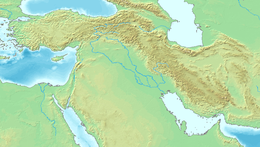Bara-irnun (𒁈𒅕𒉣 bara-ir-nun; fl. c. 2400 BC[1]) was a queen consort of the Sumerian city-state of Umma as wife of king Gishakidu. She is particularly known from a gold votive plate in which she describes her genealogy in great detail.[1] The inscription on the plate reads:
| Bara-irnun 𒁈𒅕𒉣 | |
|---|---|
| Queen consort of Umma | |
| Reign | c. 2400 BC |
| King | Gishakidu |
| Spouse | Gishakidu |
| Dynasty | 1st Dynasty of Umma |
For (the god) Shara, lord of the E-mah: when Bara-irnun - wife of Gishakidu, king of Umma, daughter of Ur-Lumma, king of Umma, grand-daughter of Enakalle, king of Umma, daughter-in-law of Il, king of Umma - had made Shara resplendent and had built him a holy throne, for her life, to Shara, in the E-Mah, she offered (this ornament).
The original royal line of Umma consisted in the filiation of Enakalle (possibly son of Ush) and his own son Ur-Lumma.[6][3] When Ur-Lumma died, presumably without a son but certainly with a daughter named Bara-irnum, the throne was handed over to Il, son of Eanandu (who had no regnal title) and grandson (or nephew) of Enakalle.[3][6] King Il was then succeeded by his own son Gishakidu.[3] Bara-irnum married her cousin Gishakidu, thus re-uniting both strands of the royal family by a marital alliance.[3][6]
The plaque is the first known mention of Shara, tutelary god of Umma.[1]
References
edit- ^ a b c d Art of the First Cities: The Third Millennium B.C. from the Mediterranean to the Indus. Metropolitan Museum of Art. 2003. p. 78. ISBN 978-1-58839-043-1.
- ^ Thomas, Ariane; Potts, Timothy (2020). Mesopotamia: Civilization Begins. Getty Publications. p. 108. ISBN 978-1-60606-649-2.
- ^ a b c d e Thureau-Dangin, F. (1937). "Une tablette en or provenant d'Umma". Revue d'Assyriologie et d'archéologie orientale. 34 (4): 177–182. ISSN 0373-6032. JSTOR 23284119.
- ^ Art of the First Cities: The Third Millennium B.C. from the Mediterranean to the Indus. Metropolitan Museum of Art. 2003. p. 78. ISBN 978-1-58839-043-1.
- ^ Thomas, Ariane; Potts, Timothy (2020). Mesopotamia: Civilization Begins. Getty Publications. p. 108. ISBN 978-1-60606-649-2.
- ^ a b c Glassner, Jean-Jacques; Foster, Benjamin Benjamin Read (2005). Mesopotamian Chronicles. BRILL. pp. 104–105. ISBN 978-90-04-13084-5.





